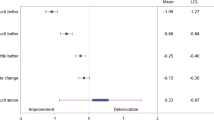Abstract
Introduction and hypothesis
Fewer than 30% of women with accidental bowel leakage (ABL) seek care, despite the existence of effective, minimally invasive therapies. We developed and validated a condition-specific instrument to assess barriers to care-seeking for ABL in women.
Methods
Adult women with ABL completed an electronic survey about condition severity, patient activation, previous care-seeking, and demographics. The Barriers to Care-seeking for Accidental Bowel Leakage (BCABL) instrument contained 42 potential items completed at baseline and again 2 weeks later. Paired t tests evaluated test–retest reliability. Factor analysis evaluated factor structure and guided item retention. Cronbach’s alpha evaluated internal consistency. Within and across factor item means generated a summary BCABL score used to evaluate scale validity with six external criterion measures.
Results
Among 1,677 click-throughs, 736 (44%) entered the survey; 95% of eligible female respondents (427 out of 458) provided complete data. Fifty-three percent of respondents had previously sought care for their ABL; median age was 62 years (range 27–89); mean Vaizey score was 12.8 (SD = 5.0), indicating moderate to severe ABL. Test–retest reliability was excellent for all items. Factor extraction via oblique rotation resulted in the final structure of 16 items in six domains, within which internal consistency was high. All six external criterion measures correlated significantly with BCABL score.
Conclusions
The BCABL questionnaire, with 16 items mapping to six domains, has excellent criterion validity and test–retest reliability when administered electronically in women with ABL. The BCABL can be used to identify care-seeking barriers for ABL in different populations, inform targeted interventions, and measure their effectiveness.


Similar content being viewed by others
References
Brown HW, Wexner SD, Segall MM, Brezoczky KL, Lukacz ES. Quality of life impact in women with accidental bowel leakage. Int J Clin Pract. 2012;66(11):1109–16.
Brown HW, Wexner SD, Segall MM, Brezoczky KL, Lukacz ES. Accidental bowel leakage in the mature women’s health study: prevalence and predictors. Int J Clin Pract. 2012;66(11):1101–8.
Xu X, Menees SB, Zochowski MK, Fenner DE. Economic cost of fecal incontinence. Dis Colon Rectum. 2012;55(5):586–98.
Brown HW, Wexner SD, Lukacz ES. Factors associated with care seeking among women with accidental bowel leakage. Female Pelvic Med Reconstr Surg. 2013;19(2):66–71.
Kunduru L, Kim SM, Heymen S, Whitehead WE. Factors that affect consultation and screening for fecal incontinence. Clin Gastroenterol Hepatol. 2015;13(4):709–16.
Dunivan GC, Heymen S, Palsson OS, et al. Fecal incontinence in primary care: prevalence, diagnosis, and health care utilization. Am J Obstet Gynecol. 2010;202(5):493.e1–6.
Whitehead WE, Palsson OS, Simren M. Treating fecal incontinence: an unmet need in primary care medicine. N C Med J. 2016;77(3):211–5.
Landefeld CS, Bowers BJ, Feld AD, et al. National Institutes of Health state-of-the-science conference statement: prevention of fecal and urinary incontinence in adults. Ann Intern Med. 2008;148(6):449–58.
Heit M, Blackwell L, Kelly S. Measuring barriers to incontinence care seeking. Neurourol Urodyn. 2008;27(3):174–8.
Brown HW, Rogers RG, Wise ME. Barriers to seeking care for accidental bowel leakage: a qualitative study. Int Urogynecol J. 2016; DOI: 10.1007/s00192-016-3195-1.
Pett MA, Lackey NR, Sullivan JJ. Making sense of factor analysis: the use of factor analysis for instrument development in health care research. Thousand Oaks, CA: Sage; 2003.
Vaizey CJ, Carapeti E, Cahill JA, Kamm MA. Prospective comparison of faecal incontinence grading systems. Gut. 1999;44(1):77–80.
Hibbard JH, Mahoney ER, Stockard J, Tusler M. Development and testing of a short form of the patient activation measure. Health Serv Res. 2005;40(6 Pt 1):1918–30.
Nunnally J, Bernstein I. Psychometric theory. New York: McGraw-Hill; 1994.
Wainer H, Braun H, editors. Test validity. Hillsdale, NJ: Lawrence Erlbaum Associates; 1988.
Gorsuch RL. Common factor analysis versus component analysis: some well and little known facts. Multivariate Behav Res. 1990;25(1):33–9.
Cronbach L. Coefficient alpha and the internal structure of tests. Psychometrika. 1951;16:297–334.
Svihra J, Luptak J, Svihrova V, Mesko D. Gender-specific external barriers to seeking care for urinary incontinence. Patient Prefer Adherence. 2012;6:773–9.
Sax L, Gilmartin S, Bryant A. Assessing response rates and nonresponse bias in web and paper surveys. Res High Educ. 2003;44(4):409–32.
Weigold A, Weigold IK, Russell EJ. Examination of the equivalence of self-report survey-based paper-and-pencil and internet data collection methods. Psychol Methods. 2013;18(1):53–70.
Author information
Authors and Affiliations
Corresponding author
Ethics declarations
Funding
This study was funded by the National Institutes of Health (NIH K12DK100022).
Financial disclaimers/conflicts of interest
Heidi Brown serves as a consultant for Grand Rounds, Inc; Kelly Brezoczky is the founder and former Chief Executive Officer of Butterfly Health, Inc; and Rebecca Rogers is a paid author for UpToDate and receives royalties from McGraw Hill. Meg Wise, Danielle Westenberg, Nicholas Schmuhl, and Melissa Constantine have nothing to disclose.
Ethical committee/institutional review board
Our protocol was deemed exempt by the Health Sciences—Minimal Risk Institutional Review Board (#2015-0785) at the University of Wisconsin-Madison and exempt category 4 (existing data) at the University of Minnesota IRB (#1509E78527).
Rights and permissions
About this article
Cite this article
Brown, H.W., Wise, M.E., Westenberg, D. et al. Validation of an instrument to assess barriers to care-seeking for accidental bowel leakage in women: the BCABL questionnaire. Int Urogynecol J 28, 1319–1328 (2017). https://doi.org/10.1007/s00192-016-3261-8
Received:
Accepted:
Published:
Issue Date:
DOI: https://doi.org/10.1007/s00192-016-3261-8




